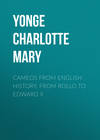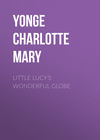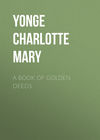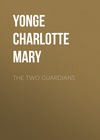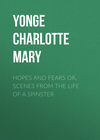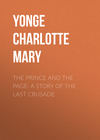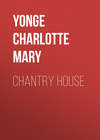Kitabı oku: «Cameos from English History, from Rollo to Edward II», sayfa 16
“You are glad to go,” he said; “but, before forty days, you will wish yourself anywhere else.”
With extreme joy did the people of Sandwich see, for the first time for seven years, the archepiscopal cross, as it stood high above the prow of the ship. They thronged to receive their pastor and ask his blessing, and in every village through which he passed the parish priest came forth, with cross or banner, his flock in procession behind him, and the bells pealing merrily, while the road was strewed with garlands.
At Canterbury the joy was extreme; anthems were sung in all the churches, and the streets resounded with trumpets and the shouts of the people in their holiday robes. The Archbishop rode through the midst, saluted each of the monks of Christ Church on the cheek, and then went straight to his own cathedral, where his greeting to his flock was a sermon on the text, “Here we have no abiding city.”
After taking possession of his palace, Becket set out to London to visit his pupil, the young King, taking him a present of a fine horse; but he was not allowed to see him, and the courtiers threatened him severely, because of the rejoicings of the citizens of London. At home he was much annoyed by his old enemy, Ranulf de Broc, who from Saltwood Castle made forays on all that were going to the archiepiscopal palace, stole his baggage, and cut off the tail of one of the poor horses that carried it.
The bishops who had been placed under the censures of the Church were, meanwhile, in violent anger. Roger of York said he had 8,000 crowns in his coffers, and would spend every one of them in beating down Thomas’s insolence: and together they all set out to make their complaints to the King, who was at Falaise.
It would seem that Henry either forgot, or did not choose to tell them, of the permission he had given Becket at Freital, and he went into a passion, saying, if all who were concerned in the coronation were to be excommunicated, he ought to be one. The Archbishop of York talked of patience and good contrivance. “What would you have me do?” said Henry.
“Your barons must advise you,” said one of the bishops (which, is not known); “but as long as Thomas lives, you will never be at peace.”
Henry’s eyes flashed. “A curse,” cried he, “on all the false varlets I have maintained, who have left me so long subject to the insolence of a priest, without attempting to rid me of him!”
A council of the barons was called, and Henry found them willing enough to advise him as he wished. “The only way to deal with such a fellow,” said one, “is to plait a few withe in a rope, and have him up to a gallows.” In the midst of the council, however, it was observed that four of the King’s knights were missing—Reginald Fitzurse, William Tracy, Hugh Morville, and William Brito. It was remembered that they had heard the King’s words about the insolent priest, and, becoming alarmed for the consequences, Henry sent off the Earl of Mandeville, and some others, with orders to overtake them, and arrest the Archbishop.
The four knights had held a hasty council, after which they set out separately, agreeing to meet in Saltwood Castle, where they were sure of assistance in their designs from Randolf de Broc. They reached it on Innocents’ day, and the next day set out for Canterbury, accompanied by several of the Broc family and their armed retainers. In the meantime, Becket had been keeping Christmas, and preaching his last sermon on the text, “Peace on earth, good-will to men.” He had sent away his cross-bearer, Alexander Llewellyn, and his high-minded friend, Herbert de Bosham, with letters to the Pope—perhaps because he was afraid that Herbert’s boldness might bring him into peril; and he was sitting in his own chamber writing, when the four knights arrived, and desired to speak with him.
He received them with his clergy about him, and they began to threaten him in the name of the King, and order him to leave the kingdom. He must fully have understood the meaning of all this; but he stood firm, and quietly answered all their railing. They then told him his doings should recoil on his own head; and on his replying that he was ready to suffer martyrdom, they noisily left the room, Fiturse shouting out, “Ho! clerks and monks, in the King’s name seize that man, and keep him till justice is done.”
“You will find me here,” answered Becket, standing by the door.
The knights had gone back to arm themselves and join their retainers. In the meantime the terrified clergy fastened all the doors of the monastery, and besought the Archbishop to take shelter in the church; but he seemed the only person present who had no fear, and replied that he would not flee—he would remain where he was. At last he was persuaded to come into church, as it was the hour for vespers, and set off, with the cross borne before him.
“My lord! my lord! they are arming!” cried one frightened monk; and another brought word that they were upon them—Robert de Broc having shown them the way through the orchard. Still Becket was calm; and as the monks tried to drag him into the church, he stood at the door, saying, “Go on with the holy service. As long as you are afraid of death, I will not enter.”
They proceeded, and he advanced up the aisle. As he was going up the steps to the altar, there was a rush of monks into the church; for Reginald Fitzurse, with a drawn sword, had just come through the cloister door, the other murderers following. Becket turned, on seeing the monks trying to bolt and bar the church doors. “It is not right,” said he; “to make a fortress of the house of prayer. It can protect its own, even if its doors are open. We shall conquer our enemies by suffering, not by fighting.”
The vespers ceased; the clergy threw themselves on the altars for protection; the Archbishop stood alone with one canon, with Fitzstephen and Edward Grim, a priest who had come to visit him. In rushed the band of armed men, crying out, “Where is the traitor, Thomas Becket?” To this he made no answer; but when the cry was, “Where is the Archbishop?” he came down the steps, saying, “Here I am; no traitor, but a priest of the Lord. What would you of me?”
“Absolve those you have excommunicated.”
“They have not repented, and I will not.”
“Then you shall die.”
“I am ready, for the Lord’s sake; but, in the name of Almighty God, I forbid you to harm these, whether priests or laymen.”
“Flee, or you are a dead man!” cried one, striking him with the back of his sword, and unwilling, apparently, to slay him in the church. They tried to push him away from the pillar against which he was standing, but in vain. Becket was a tall, powerful man, expert in the use of weapons. Had he snatched a sword from one of these, he might have saved his life; but temporal arms he had long since laid aside, and he only stood still, clasped his hands in prayer, and commended his soul to his God. Reginald Fitzurse began to fear the people might break in to his rescue, and struck a blow which wounded his head, as well as the arm of Edward Grim, who fled to the altar; but Becket did not move hand or foot—only, as the blood flowed from his face, he said, “In the name of Christ, and for the defence of the Church, I am ready to die.” Tracy struck him again twice on the head: he staggered, and, as he was falling, the fourth stroke, given by Brito, cleft off the top of his skull with such violence, that the sword broke against the pavement.
The murderers, after making sure of his death, left the church; the monks took up his corpse, unwounded, save the crown of his head, which was shattered to pieces above his tonsure, and laid it out on the high altar, deeming that he had indeed been a sacrifice, and weeping as they beheld the beauty of his peaceful expression, as if he had calmly fallen asleep. They folded outward the haircloth shirt he had always worn secretly; and as the blood still trickled from the wound, it was caught in a dish.
The threats of Randolf de Broc obliged them to bury him in haste the next morning; and they were strictly forbidden to place his coffin among those of the former archbishops—a command which they obeyed, from the dread that otherwise his remains might be insulted. They had not long to fear. Europe rang with horror at the crime, and admiration, rather than compassion, for the victim. No one was more shocked than the King himself, who was at Bure, in Normandy, when the news reached him. For three days he remained shut; up in his room, taking no food, and seeing no one, in an agony of grief and dismay at the consequence of his hasty words, and dwelling on those days of early friendship which he had passed with the murdered Becket. Not till these first paroxysms of grief were over was he even able to think of the danger he was in; and he then sent off an embassy to explain to the Pope how far he was from intending the bloody deed, and to entreat forgiveness.
He was at a loss how to treat the murderers. He could not punish what his own words had been supposed to authorize, and he dared not let them escape, lest he should be supposed to be their defender. He therefore let them reap the benefit of the liberties for which Becket had died: their crime was done on the person of a clerk; therefore it was left to the censures of the Church.
They had, in the meantime, fled to Morville’s Castle, in Cumberland, where they found themselves regarded with universal execration; their servants shrank from their presence, and, in the exaggerations of tradition, it was said that the very dogs would not approach them.
Overwhelmed with remorse, they set out for Italy, and dreaded and avoided, as if they bore a mark like the first “murderer and vagabond,” they threw themselves at the feet of the Pope, and entreated to know what they should do to obtain mercy. He ordered them to go on pilgrimage to Jerusalem; and they all went except Tracy, who, lingering behind, was seized with a dreadful illness, and died at Cosenza. The others all died within three years, with deep marks of penitence, and were buried before the door of the Church of the Holy Sepulchre.
Henry obtained pardon from the Pope on giving up all attempts at subjecting the Church to the law of the State, and on giving a large sum of money to maintain 200 knights for three years in the Holy Land. He also largely endowed Mary and Agnes Becket, the Archbishop’s sisters, with possessions in his newly-conquered domain in Ireland; and one of them became the ancestress of the noble family of Butler, Earls of Ormonde.
The cathedral at Canterbury had, in the meantime, been sprinkled with holy water, to purify it from the crime of sacrilege and murder there committed, and for which it had been a whole year left neglected, and without the celebration of Divine service. On its reopening, gifts poured in from all quarters, in honor of the Archbishop, and it was repaired and beautified to a great degree. The beautiful circular chapel at the east end was named Becket’s Crown, and the spot by the north transept, where he fell, was termed The Martyrdom. Reports of miracles having been performed at his intercession were carried to Rome, and Pope Alexander canonized him as St. Thomas of Canterbury. The next year, 1174, Henry II., who was broken down with grief at the rebellion of his sons, rode from Southampton to Canterbury without resting, taking no food but bread and water, entered the city, and walked through the streets barefoot to the cathedral, and into the crypt, where he threw himself prostrate on the ground, while Gilbert Folliot preached to the people.
In the chapter-house Henry caused each of the clergy present, to the number of eighty, to strike him over the shoulders with a knotted cord, and afterward spent the whole night beside the tomb. He heard mass the next morning, and returned to London.
A few years after, Louis VII. came to pray at the tomb of his friend for the recovery of his son Philippe Auguste, who was ill of a fever. He made splendid gifts to the cathedral, and in especial a very large diamond, and a golden cup. In Italy Thomas was equally honored. William the Good, of Sicily, who married Joan, daughter to Henry II., placed a colossal statue of St. Thomas of Canterbury in his new foundation, the Church of Monreale; and at Agnani there is still preserved a richly-embroidered cope, presented by Pope Innocent III., bearing thirty-six different scenes in delicate needlework, and among them the death of the English Archbishop. There are also many German and French representations of the subject; the murderers, in the more ancient ones, carefully distinguished by their shields: Morville, fretty fleur-de-lis; Tracy, two bars gules; Brito, three bears, heads muzzled; Fitzurse, three bears passant.
In Henry III.‘s reign a new shrine was built at Canterbury, and the Archbishop’s relics were thither translated. No saint in England was more popular than St. Thomas of Canterbury, and frequent pilgrimages were made to his shrine. The Canterbury Pilgrims of Chaucer are thither journeying, and Simon of Sudbury, the archbishop killed by Wat Tyler’s mob, is said to have made himself unpopular by rebuking the superstition that made the ignorant believe in the efficacy of these pilgrimages.
Then came the reaction. Henry VIII., little able to endure such a saint as Becket, sent the spoilers to Canterbury. Lord Cromwell burnt his relics, and carried off the treasures of gold and jewels, which filled two chests, so heavy that six or eight men were wanted to carry each of them. Henry wore Louis VII.‘s diamond in a ring. The costly shrine was destroyed, and the pavement, worn by the knees of the pilgrims, alone remained to show where Becket’s tomb had been. In London, the house of Gilbert à Becket, in Southwark, where the Saracen lady had ended her toilsome journey, and where Thomas had been born, had, in Henry III.‘s reign, been made a hospital; Edward VI. granted it for the same use; and thus it still remains, by its old name of St. Thomas’s Hospital, which perhaps would not so generally be given it, if it were known after what saint it was so called. His likeness was destroyed in every church and public building, so that but one head of St. Thomas à Becket is known to exist in England—namely, one in stained glass, at the village of Horton, in Ribblesdale—and even in missals and breviaries it was defaced.
No one has met with more abuse than Becket, ever since the Reformation. Proud, ostentatious, hypocritical, and rebellious—these are the terms usually bestowed on him. How far he deserves them, may be judged from a life detailed with unusual minuteness by three intimate companions, none of them treating him as faultless. Of the rights of the struggle we will not speak. No one can doubt that Becket gave his life for the cause which, in all sincerity, he deemed that of the Church against the World.
The fate of the murderers has been questioned in later times. It is said that they died at home, in peace and fair prosperity; but the evidence on either side is nearly balanced.
CAMEO XXII. THE CONQUEST OF IRELAND. (1172)
Few histories are more strange and confused than the Irish. The inhabitants of Ierne, or Erin, as far as anything credible can be discovered about them, were of three different nations, who had in turn subdued the island before the beginning of history. These were the Tuath de Dunans, the Firbolg, and the Scots, or Milesians. Who the two first were, we will not attempt to say, though Irish traditions declare that some of them were there before the Flood, and that one Fintan was saved by being transformed into a salmon, and so swimming about till the water subsided, after which he resumed the human form, and lived so long that the saying was, “I could tell you much, if I was as old as Fintan.”
The Milesians are not much behind their predecessors in their claim, for they say they are descended from a son of Japhet, and first discovered writing, and all the arts commonly said to have been derived from Egypt, but which they assert were carried thither by one Neill, who gave his name to the river Nile, as well as to his sons, all the O’Neills of Ireland.
It is more certain that these Milesians were Kelts, and were in early times called Scots. A colony of them conquered the Picts; drove the Caledonians into Galway, and gave North Britain, or Albin the name of Lesser Scotland, while their own country, or Greater Scotia, returned to its former name of Erin, called by the Romans Hibernia, and by the English, Ireland.
The Erse tongue is nearly the same as the Gaelic, and there was much in the Irish and Highland institutions showing their common origin. The clan system prevailed in Ireland, the clans being called Septs, and all having, as a surname, the name of the common ancestor. His representative, the chief, was known as the Carfinny; but the succession was not determined by the rules of primogeniture. It was always in one family, but the choice was made by election of the next heir. When a Carfinny died, another came into office who had been chosen on his accession as heir, or Tanist, and at the same time another Tanist was chosen to succeed him as Carfinny at his death. The land was the property of the tribe, divided into holdings; and whenever the death of a considerable proprietor took place, there was a fresh allotment of the whole, which, of course, as well as the choice of a Tanist, set the whole population at war.
There were four kingdoms—Ulster, Munster, Leinster, and Connaught—to which the chiefs succeeded by tanistry, besides Meath, another kingdom which always belonged to the principal king, or Toparch, who was in like manner elected as Tanist on each new accession; and the number of battles and murders among these wild Irish princes is beyond all estimate. Out of 178 kings, 71 were slain in battle, and 60 murdered.
Christianity was brought to Ireland about the year 400, by St. Colman and St. Patrick. It does not seem to have materially softened the manners of the people at large, whose wars went on as fiercely as ever; but the churches were seats of peace and learning, whence teachers went forth in numbers into Gaul, and among the heathen Saxons of England. The Roman calender shows so many names of Irish hermits, priests, and nuns, that we do not wonder Erin once was known as the Isle of Saints.
The Northmen made their cruel inroads on Ireland, and swept away much of the beginnings of civilization. Turges, a Danish chief, was, in 815, King of all Ireland; and having forced Melachlin, or Malachy, King of Meath, to give up his daughter to him, Melachlin sent with her, in the disguise of female attendants, sixteen young men armed with skeynes, or long knives. They killed Turges, and brought the princess back to her father, who was waiting in ambush at no great distance with his armed men, set upon the Danes, defeated them, and, being joined by the other Irish princes, destroyed them all.
It is said that shortly before, Melachlin, when at the court of Turges, had told him that Ireland was full of a kind of foul, ravenous bird, and asked his advice how to get rid of them; to which Turges answered, that he had better destroy the nests—eggs, nestlings, and all—counsel which the Irish hardly needed; and the massacre of the Danish raven’s brood was frightful.
During the lull brought about by Alfred’s conquests, the Irish enjoyed the halcyon days remembered as those of Malachy with the collar of gold (which he had torn from the neck of a conquered Dane), and those of Brien Boromhe, or Boru, the great Brien, in whose reign a maiden, though
“Rich and rare were the gems she wore,”
travelled safely round the Green Isle unprotected,
save by “Erin’s honor and Erin’s pride.”
But when England suffered again, Ireland shared its fate, and, in 1004, Brien Boru, at the age of eighty-eight, perished in the great battle of Clontarf, with his eldest son Morogh, and the Danes gained a permanent settlement, besides making endless forays on the coast. King Olaf Trygvesson, of Norway, conducted one of these descents; and while driving off a large herd of cattle, a peasant so piteously entreated to have his own cows restored, that the king told him he might take them, if he could tell at once which they were, but that he must not delay the march. The peasant said his dog knew them, and sent the animal into the midst of the herd, which consisted of several hundreds, when he drove out just the number his master had asked, and all bearing the same mark. The King desired to purchase the intelligent animal, but the man begged that he would take it as a gift; on which Olaf presented him with a gold ring, and kept and valued the faithful Vige as “the best of dogs” for many years after.
Turlogh, the contemporary of the Conqueror, seems to have been prosperous, since his subjects were rich enough to buy the unfortunate English, who were sold for slaves, till St. Wulstan put a stop to the traffic.
Morogh O’Brien, of Leinster, sent to William Rufus bog oak from the green of Oxmanton, on the Liffey, to serve for the timber of the roof of Westminster Hall; and this wood, enjoying the universal Irish exemption from vermin, is said never to harbor a spider. Morogh was once told that William Rufus intended to make a bridge of his ships, and conquer Ireland. After some musing, Morogh asked, “Hath the King, in his great threatening, said, ‘If it please God?’” “No!” “Then, seeing he putteth his trust only in man, and not in God, I fear not his coming.”
Morogh was a peaceable man. Magnus, the Norse King of Man, by way of defiance, sent him his shoes, ordering him to hang them on his shoulders on Christmas-day, as he passed through his hall. The Irish were, of course, much enraged at the insult offered to their master, but Morogh only laughed at the folly of the conceit, saying, “I will not only bear his shoes, but I had rather eat them, than that he should destroy one province in Ireland.” Magnus did not, however, give up his purpose of invasion, but was killed in reconnoitring the coast. Morogh was murdered at Dublin about 1130, and thenceforward all was dire confusion.
The Irish Church had never been decidedly under the dominion of Rome, and the Popes, in the divided state of the country, obtained neither money nor obedience from it. They thought much advantage might be gained if it were under the rule of England; and in 1154, Adrian IV., assuming that all islands were at the disposal of the Church, gave Henry II. a bull, authorizing him to become Lord of Ireland, provided he would establish the Pope’s authority there. However, the Irish, not being likely readily to receive their new Lord, and Henry having full occupation at home, allowed his grant to rest in oblivion till circumstances arose to enable him to avail himself of it.
Dermod MacMorogh, King of Leinster, a cruel savage, who had barbarously revenged the death of his father, the good Morogh, had, in the year 1152, stolen away Devorghal, the wife of Tigheirnach O’Rourke, Prince of Breffny. The toparch, Turlogh O’Connor, was the friend of O’Rourke, and forced Dermod to make restitution, but the husband and lover, of course, remained bitter enemies; and when O’Connor died, the new chieftain, O’Lachlan, being on the side of Dermod, O’Rourke was severely oppressed, till the tables were turned by O’Lachlan being killed, and Roderick O’Connor, the son of Turlogh, becoming toparch. Thereupon Leinster was invaded in 1167, and Dermod was obliged to flee, setting fire to his capital at Ferns. He hastened to Henry II. in Normandy, and offered his allegiance, provided the King would restore him. But Henry was too much engaged in his disputes with France to attend to the matter, and all Dermod could obtain was a letter permitting the English knights to take up his cause, if they were so inclined.
With these letters Dermod sought the fierce Normans whose estates bordered on Wales. The first who attended to him was Richard de Clare, son of the Earl of Pembroke, and surnamed Strongbow—a bold, adventurous man, ruined by his extravagance, and kept at a distance by the King on account of his ambition. To him Dermod offered the hand of his daughter Eva, and the succession of Leinster, provided he would recover for him the kingdom. Richard accepted, but thought it prudent to obtain the King’s special permission; and in the meantime, Dermod, by his promises, further engaged in his cause a small band of other knights—Robert Fitzstephen, Maurice Fitzgerald, Milo Fitzhenry, Hervé de Montmarais, and some others. In May, 1169, thirty knights, sixty men-at-arms, and three hundred archers, landed at the Creek of Bann, near Wexford, to conquer Ireland.
They first besieged Wexford, and took it; then attacked the Prince of Ossory, and gained a great victory; after which they had full opportunity of seeing of what a savage they had undertaken the defence, for Dermod mangled with his teeth the face of his chief foe among the slain, to gratify his revenge.
However, they fought not for the right, but for the spoil; and when Roderick O’Connor sent to declare war against them, and inform them of the true character of their ally, they returned a scornful answer; and, with their heavy armor and good discipline, made such progress against the half-armed Irish kernes, that Richard Strongbow saw the speculation was a good one, and was in haste for his share. He went to the King, to beg him either to give him his inheritance, or to grant him leave to seek his fortune in other lands. “Go where thou wilt, for what I care,” said Henry. “Take Daedalus’s wings, and fly away.”
Taking this as sufficient consent, Strongbow sent before him 3,000 men under his friend Raymond le Gros, and, landing on St. Bartholomew’s day, joined his forces with Dermod, took Waterford, and in a few days was married to Eva. The successes of the English continued, and on the death of Dermod, which took place shortly after, he declared Earl Richard his heir. However, the vassals would not submit to the Englishman, and the invaders were for a time hard beset, and found it difficult to keep the enemy at bay, while the King in great displeasure peremptorily summoned Strongbow to return, and forbade men, horses, or arms to be sent to his aid. On this Richard found himself obliged to make his peace with the King, sending Raymond le Gros and Hervé de Montmarais before him. The King was at Newnham, in Gloucestershire, and at first refused to see him, but soon relented; and Richard, on entering his presence, threw himself on his knees, and gave up to him the city of Dublin, and all other towns and castles on the coast, after which Henry confirmed him in the possession of the rest of Leinster, and made him Seneschal of Ireland, though at the same time confiscating his castles in Pembrokeshire, because his expedition had been unsanctioned. In October of the next year, 1172, Henry himself came to Ireland, with 500 knights and 4,000 men-at-arms. The Irish princes felt that it was needful to submit to such power, nor was it with much reluctance on the part of the toparchs, who had some pride in being under the sway of the mighty Henry Fitzempress, rather than that of the petty chieftain of Meath.
Henry professed not to come as a conqueror, but in consequence of the Pope’s grant, and soon received the submission of all the toparchs of Leinster and Munster. Roderick O’Connor himself did not hold out, though he would not come to the King, and only met Hugo de Lacy and William Fitz Adhelm on the Shannon, where he swore allegiance, but, as appeared afterward, with a mental reservation—Connaught he was willing to hold under Henry, but Ireland he neither could nor did yield up.
Henry invited all these new subjects of his to keep Christmas with him at Dublin, where he entertained them in a temporary structure of wicker-work, outside the gates; and after receiving their homage, he gave them a banquet of every kind of Norman delicacy, among which were especially noticed roasted cranes—a food hitherto held in abhorrence by them, so that partaking of it was a sort of pledge that they were about to forsake their peculiar and barbarous habits. They are said to have been much impressed by the splendor of Henry’s gold and jewels, the rich robes of his court, and the chivalrous exercises of the knights and nobles. Afterward he held a synod of the Irish clergy at Cashel, where he caused the bull of Adrian to be read, and regulations were made for the Church, requiring the priests to catechize children and baptize them, enforcing the payment of tithes, and the performance of Divine service, as well as that corpses should receive Christian burial. Henry had intended to subject Ireland to English law, but the danger in which he had been involved by the murder of Becket obliged him to return at Easter, before his arrangements were completed. The lands settled by the Normans around Dublin, which were called the English pale, were alone under English laws; besides five septs—the O’Neills, the O’Connors, the O’Briens, the O’Lachlans, and the MacMoroghs—all the rest were under the Brehon, or Irish law; and an injury, or even murder done by an Englishman on one of the Irish, was to be atoned for by a fine according to this code.
Hugo de Lacy, [Footnote: The readers of “The Betrothed” will here recognise a friend.] constable of Chester, an old, experienced warrior, much trusted by the King, was made governor of Ireland with a grant of the county of Meath. Shortly after, Oraric, a chieftain of that territory, invited De Lacy to a conference on the hill of Tara, whither each party was to come unarmed. The night before the meeting young Griffith, the nephew of Maurice Fitzgerald, dreamt that he saw a herd of wild boars rush upon his uncle and Hugo de Lacy, and tear them to pieces with their tusks. Treating this dream as a warning, he chose seven tall men of his own kindred, armed them well, and, leading them near the place of conference, began to career about with them as if in chivalrous exercises, always watching the assembly on the hill.
